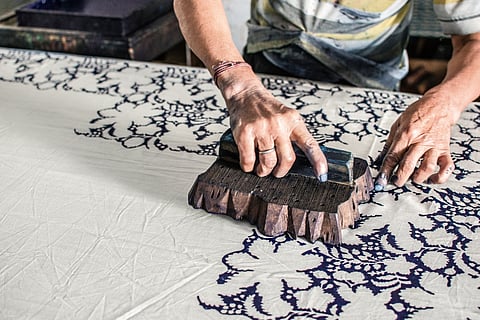
- Destinations
- Experiences
- Stay
- What's new
- Celebrating People
- Responsible Tourism
- CampaignsCampaigns
- Subscribe
- Buy Now

About 16 km south of the Pink City Jaipur lies the little less known town of Sanganer. Why one should know this place is delineated in the fact that the artisanal traditions of the city predate the Pink City itself. Long renowned for its textile printing, handmade paper industry as well as Jain temples, the city commands credence for mainly its handcraft. Sanganer has been a cradle of craftsmanship for over 400 years and its legacy continues to captivate both connoisseurs and casual visitors alike.
The association between Sanganer and hand-block printing goes as far back as the 16th century. It was the Chipa community, skilled in dyeing and printing, that migrated here and set off the tradition of textile industry turning it into the town's own identity. The region's surplus water resources and its proximity to Jaipur further enhance it as the locus for this craft. Similarly, the Kagzi community, known for papermaking, found Sanganer's environment conducive to their trade and benefitted from royal patronage under the dais of Maharaja Sawai Jai Singh II.
First, artists carve elaborate patterns onto blocks of wood, usually teak or sheesham. After being soaked in natural dyes, these blocks are imprinted into textiles, usually silk or cotton. To guarantee that patterns match smoothly, the procedure needs to be precise.
Using resources like cotton rags, used paper, and agricultural waste, the Kagzi community uses traditional ways. These are soaked, pulped, and then spread out into sheets on screens. To get a smooth finish, the paper is polished with stones once it has dried.
Sanganeri prints are usually depicted on white or off-white backgrounds and are distinguished by their delicate flower designs, thin lines, and vivid colours. With patterns like buta and buti, the designs sometimes take inspiration from Mughal art.
Handmade paper from Sanganer is renowned for its distinctive texture and longevity. It is frequently employed in creative pursuits, religious literature, and calligraphy. The paper's eco-friendly manufacturing method contributes to its modern attractiveness.
Although Sanganer's crafts still rely heavily on traditional methods, contemporary adjustments have been made. In order to serve international markets, artisans are now experimenting with modern styles. Tourists can have hands-on experience in workshops and studios, which promotes appreciation and helps to preserve the crafts.
Over the years, Sanganer's craft have significantly contributed to India's cultural as well as economic landscape. The town's artisans have garnered international acclaim, exporting their products around the world. The Geographical Indication (GI) tag awarded to Sanganeri hand-block prints in 2010 further cemented their reputation with all its cultural uniqueness and importance.
Furthermore, these crafts provide livelihoods to numerous families, preserving age-old traditions and promoting sustainable practices. As global interest in eco-friendly and handmade products grows, Sanganer's legacy continues to thrive, bridging the past with the present.
